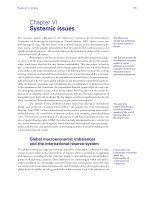PETROLEUM DEVELOPMENT GEOLOGY PETRO GEOL
Bạn đang xem bản rút gọn của tài liệu. Xem và tải ngay bản đầy đủ của tài liệu tại đây (3.54 MB, 31 trang )
a.
b.
c.
d.
e.
SOURCE ROCKS & MATURATION
HYDROCARBON MIGRATION
CAP ROCKS / SEALS
STRUCTURE / TRAP
RESERVOIR ROCKS
Petroleum System Processes
• Generation - Burial of source rock to temperature and
pressure regime sufficient to convert organic matter into
hydrocarbon
• Migration - Movement of hydrocarbon out of the source
rock toward and into a trap
• Accumulation - A volume of hydrocarbon migrating into
a trap faster than the trap leaks resulting in an
accumulation
• Preservation - Hydrocarbon remains in reservoir and is
not altered by biodegradation or “water-washing”
• Timing - Trap forms before and during hydrocarbon
migrating
Petroleum System Processes
Gas
Cap
Oil
Entrapment
Accumulation
Water
Seal Rock
Reservoir
Rock
Migration
120° F
Source
Rock
Generation
350° F
2480
SOURCE ROCKS
• Hydrocarbon originates from
minute organisms in seas and
lakes. When they die, they sink to
the bottom where they form
organic-rich "muds" in fine
sediments (usually become gray–
black shale).
• These "muds" are in a reducing
environment or "kitchen", which
strips oxygen from the sediments
leaving hydrogen and carbon.
• The sediments are compacted to
form organic-rich rocks with very
low permeability.
• The hydrocarbon can migrate
very slowly to nearby porous
rocks, displacing the original
formation water.
The principal zone of oil formation
during the thermal generation of
petroleum hydrocarbons
• If the temperature is too
low, the organic material
cannot transform into
hydrocarbon.
• If the temperature is too
high, the organic material
and hydrocarbons are
destroyed.
HYDROCARBON MIGRATION
•
Hydrocarbon migration takes place in two stages:
– Primary migration - from the source rock to a porous rock. This is a
complex process and not fully understood. It is probably limited to a
few hundred metres.
– Secondary migration - along the porous rock to the trap. This occurs
by buoyancy, capillary pressure and hydrodynamics through a
continuous water-filled pore system. It can take place over large
distances.
CAP ROCK
• A reservoir needs a cap rock.
• Impermeable cap rock keeps the
fluids trapped in the reservoir.
• It must have zero permeability.
• Some examples are:
– Shales.
– Evaporites such as salt or anhyhdrite.
– Zero-porosity carbonates.
TRAPS
GENERAL
The reservoir form depends on the
depositional environment and post depositional
events such as foldings and faulting.
The criteria for a structure is that it must have:
•Closure, i.e. the fluids are unable to
escape.
•Be large enough to be economical.
STRUCTURAL TRAPS
Structural traps are formed where the space for
petroleum is limited by a structural feature
• Tilted fault-block traps are formed where the upward flow of the
petroleum is prevented by impermeability along the fault plane
and by an overlying cap or seal: common in the North Sea.
• Anticlinal traps are
formed by folding
in the rocks.
• Unconformity
traps are
generated where
an erosional break
in the stratigraphic
succession is
followed by
impermeable
strata.
SALT DOME TRAP
•
Salt Dome traps are caused when "plastic" salt is forced upwards.
•
The salt dome pierces through layers and compresses rocks
above. This results in the formation of various traps:
•
In domes created by formations pushed up by the salt.
•
Along the flanks and below the overhang in porous rock abutting
on the impermeable salt itself.
STRATIGRAPHIC TRAPS
̈Stratigraphic
traps are traps
created by the
limits of the
reservoir rock
itself, without
any structural
control.
PETROLEUM RESERVOIR ROCKS
DEFINITION
• A body of porous and permeable rock
containing oil and gas through which
fluid may move toward recovery
opening under the pressure existing or
that may be applied. (Amyx, 1960)
TYPE OF RESERVOIR ROCKS
c Sedimentary:
Ü Clastic ; eg. Sandstone, Conglomerate
Ü Non Clastic ; eg. Limestone, Evavorite.
c Igneous:
Ü Plotunic ; e.g. Granite
Ü Volcanic ; eg. Basalt
Ü Volcanic Clastic : eg Tuff, Breccia.
c Metamorphic:
Ü eg. Marble, gneiss, quartzite, slate etc.
Reservoir Rocks
î
Reservoir rocks need two properties to be successful:
1. Pore spaces able to retain hydrocarbon.
2. Permeability which allows the fluid to move.
DEFINITION OF POROSITY
Porosity = φ =
Vp
Vb
=
Vb − Vma
Vb
POROSITY SANDSTONES
•
•
The porosity of a sandstone depends on the packing arrangement
of its grains.
The system can be examined using spheres.
In a Rhombohedral packing, the pore
space accounts for 26% of the total
volume.
With a Cubic packing
arrangement, the pore space fills
47% of the total volume.
In practice, the theoretical value is rarely
reached because:
a) the grains are not perfectly round, and
b) the grains are not of uniform size.
POROSITY AND GRAIN SIZE
• A rock can be made up of small grains or
large grains but have the same porosity.
• Porosity depends on grain packing, not the
grain size.
• Total porosity, φt =
Total Pore Space
Bulk Volume
• Effective porosity, φe =
Interconnected Pore Space
Bulk Volume
• Very clean sandstones : φt = φe
• Poorly to moderately well -cemented intergranular
materials:
φt ≈ φe
• Highly cemented materials and most carbonates:
φe < φt
DIAGENESIS
•
•
The environment can also involve subsequent alterations of the
rock such as:
Chemical changes.
Diagenesis is the chemical alteration of a rock after burial. An
example is the replacement of some of the calcium atoms in
limestone by magnesium to form dolomite.
•
Mechanical changes - fracturing in a tectonically-active region.
•
CARBONATE POROSITY TYPES
•
Carbonate porosity is very heterogeneous. It is classified into a
number of types:
Interparticle porosity: Each grain is
separated, giving a similar pore space
arrangement as sandstone.
Intergranular porosity: Pore space is
created inside the individual grains
which are interconnected.
Intercrystalline porosity: Produced by
spaces between carbonate crystals.
Mouldic porosity: Pores created by the
dissolution of shells, etc.
CARBONATE POROSITY TYPES
Fracture porosity:
• Pore spacing created by the
cracking of the rock fabric.
Channel porosity:
• Similar to fracture porosity
but larger.
Vuggy porosity:
• Created by the dissolution
of fragments, but
unconnected.
CARBONATE POROSITY
• Intergranular porosity is called "primary
porosity".
• Porosity created after deposition is called
"secondary porosity".
• The latter is in two forms:
– Fractures
– Vugs.
FRACTURES
•
Fractures are caused when a rigid rock is strained beyond its
elastic limit - it cracks.
•
The forces causing it to break are in a constant direction,
hence all the fractures are also aligned.
•
Fractures are an important source of permeability in low
porosity carbonate reservoirs.
VUGS
• Vugs are defined as non-connected pore space.
• They do not contribute to the producible fluid total.
• Vugs are caused by the dissolution of soluble
material such as shell fragments after the rock has
been formed.
• They usually have irregular shapes.
PERMEABILITY
• The rate of flow of a liquid through a
formation depends on:
– The pressure drop.
– The viscosity of the fluid.
– The permeability.
• The permeability is a measure of the ease at
which a fluid can flow through a formation.
• The unit of measurement is the Darcy.
• Reservoir permeability is usually quoted in
millidarcies, (md).









